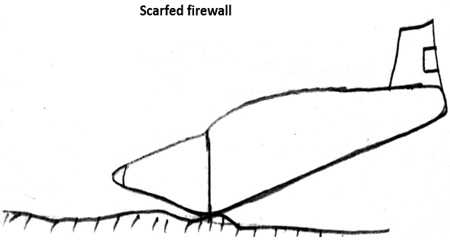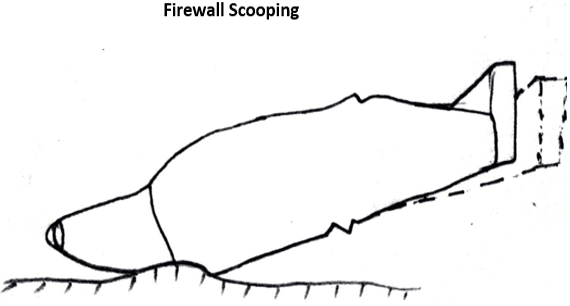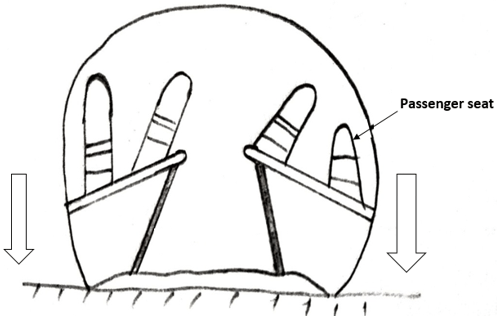This set of Aircraft Design Multiple Choice Questions & Answers (MCQs) focuses on “Configuration Layout – Crashworthiness Considerations”.
1. Positioning of the propeller should be such that _____________
a) blade will not strike anyone if they fly off
b) blade should fly off during flight
c) it is always near to cabin
d) the blades will strike the engine
View Answer
Explanation: As a crashworthiness consideration, positioning of the propeller should be such that the blades will not strike anyone in case of failure or emergency. Hence, as a designer it is our primary role to ensure not only performer but also safety of passengers as well.
2. Typically, in a passenger aircraft fuel is not located in the fuselage.
a) True
b) False
View Answer
Explanation: Typically, it is advised to not locate fuel tanks under the fuselage. Fuel tanks can increase flames spreading tremendously. Hence, to avoid such a scenario it should not be located below or in the fuselage.
3. Following diagram represents ____________

a) Scarfed firewall reduces scooping
b) Scarfed firewall increases scooping
c) RCS exposed only
d) Wetted area only
View Answer
Explanation: The above diagram is representing the effect of scarfed firewall. As shown it reduces the scooping. RCS is measurement of radar detection. Wetted area will affect aerodynamics of design.
4. What do you mean by crashworthiness?
a) Capability of structure to protect against impacts and crash loads
b) Capability of an aircraft to stay in cruise
c) Vulnerability to radar detection
d) Special aerodynamic lift improvement
View Answer
Explanation: Capability of structure to protect against impacts and crash loads can be termed as crashworthiness design. Whether the aircraft will stay in cruise or not this will be decided by operating environment.
5. Following diagram represents _____________

a) increment in crash load due to firewall scooping
b) crash load decrement
c) firewall scooping has decreased crashworthiness
d) wing loading concept
View Answer
Explanation: Above diagram is showing scooping effect. As shown in the figure, because of the scooping crash loads has increased. Wing loading will be used to size the aircraft. Based on mission and type of aircraft we can size our design by using wing loading concepts.
6. For large passenger aircraft, floor should be supported by braces at lower part of the fuselage.
a) True
b) False
View Answer
Explanation: Typically, it is not advised to use such arrangements. If this type of arrangement is used then, it may affect the safety of aircraft at the time of the crash. Hence, it should be avoided.
7. Following diagram represents _____________

a) effect of struts located below passenger cabin
b) most efficient design of an aircraft
c) better crashworthiness design
d) best crashworthiness structure
View Answer
Explanation: Effect of placing strut below passenger cabin is shown in the above diagram. As shown in figure, it strut is placed as shown then, during crash it will increase damage to passenger. This lowers safety of passengers and hence, should be avoided to reduce such effects.
8. Location of landing gear should be such that _____________
a) they wouldn’t rip open fuel tanks at the time of crash
b) they would rip open fuel tanks
c) they must rip open fuel tank during crash
d) with less crashworthiness
View Answer
Explanation: Gears should be placed such that they would not rip open fuel tank at the time of crash. Location should be selected by considering crashworthiness as well. If location is not adequate then, it will damage to crashworthiness properties of our design.
9. Which of the following is correct?
a) We should avoid placing heavy items behind or above people
b) Lift is always same as weight
c) Drag is always same as thrust
d) Heavy items can be placed as we want
View Answer
Explanation: Lift is not always same as weight. Drag is not necessarily to be same as thrust. Heavy items should be placed as per structural and crashworthiness considerations. Heavy items should not be placed behind or above people or passenger compartment.
10. Which of the following is incorrect?
a) Designer should not worry about crashworthiness
b) Designer should worry about crashworthiness
c) Careful and adequate design can improve crashworthiness
d) Redundant system can be used during failure
View Answer
Explanation: Designer should worry about crashworthiness of design. Crashworthiness design can be adopted in order to improve safety. We can use a redundant system to improve the crashworthiness.
Sanfoundry Global Education & Learning Series – Aircraft Design.
To practice all areas of Aircraft Design, here is complete set of 1000+ Multiple Choice Questions and Answers.
If you find a mistake in question / option / answer, kindly take a screenshot and email to [email protected]
- Apply for Aerospace Engineering Internship
- Check Aeronautical Engineering Books
- Check Aircraft Design Books
- Practice Aeronautical Engineering MCQs
- Practice Aerospace Engineering MCQs
